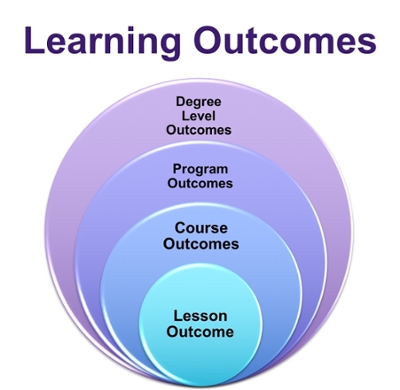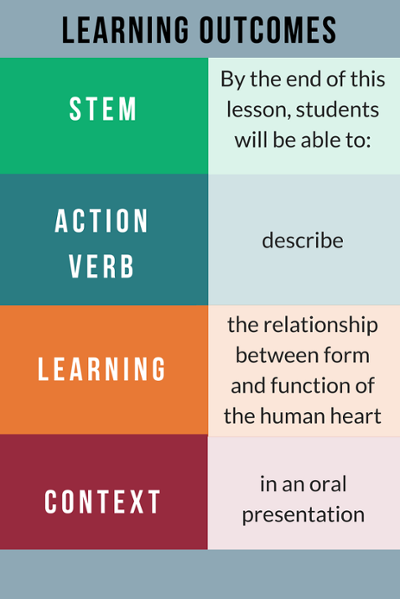Curriculum
Upcoming Events
All | Faculty | Grad Students
Contact
Centre for Teaching and Learning
Weldon Library (WL), Room 200
(519) 661-2111 x80346
ctl@uwo.ca
Learning Outcomes
 Learning outcomes are statements referring to the specific knowledge, practical skills, areas of professional development, attitudes, or higher-order thinking skills that instructors expect students to develop, learn, or master by the end of their learning (Suskie, 2009). Learning outcomes are written from the student’s perspective, describing what they will be able to know, do, or value as a result of successfully completing their learning.
Learning outcomes are statements referring to the specific knowledge, practical skills, areas of professional development, attitudes, or higher-order thinking skills that instructors expect students to develop, learn, or master by the end of their learning (Suskie, 2009). Learning outcomes are written from the student’s perspective, describing what they will be able to know, do, or value as a result of successfully completing their learning.
Learning outcomes can be written at the lesson-, course-, program-, or degree-level and, ideally, a connection is made between the learning that is expected at each of these types. For example, a concept learned in class connects to the broader outcomes of the course, which in turn contributes to the outcomes of the program and the expectations for degree completion.
Qualities of Effective Learning Outcomes
Learning outcomes typically include the following elements:
- a short and consistent stem such as “By the end of this course/program, succesful students will be able to…”
- an action verb that identifies the depth of learning expected
- a statement of the learning to be demonstrated - addressing the what
- a statement of the context in which this learning will occur - addressing the how? or why?

Important Considerations
In selecting an action verb, consider the most appropriate type of performance, whether it is in the cognitive, behavioural, or affective domain for your students. Also consider the type of performance that students are expected to reach by the end of their learning. For assistance with this, we recommend taxonomies of learning, such as Bloom’s, and associated verbs:
It is also important to consider how learning is demonstrated, using concrete actionable or operational verbs (such as create, apply, interpret, describe, identify) rather than verbs that are difficult to measure (such as know, learn, become aware of, experience).
Why communicate outcomes to students?
“Those who know where they intend to go have a better chance of getting there” (Undergraduate Program Review Audit Committee, 2006)
Students’ learning is enhanced when they know what is expected of them (Marsh, 2007; Trigwell & Prosser, 1991). When learning outcomes are communicated to students, they are more likely to take deep approaches to learning and tend to hold more favourable perceptions of their courses and instructors.
However, helping students reach learning outcomes takes more than simply listing those outcomes in your syllabus (Schoepp, 2017).
Learning outcomes are most influential when students can see the connection between intended course outcomes and course requirements (i.e. activities and assessments). Consider taking one of the following approaches for making this connection clear:
- list course outcomes and assignments side-by-side to show how each outcome is to be demonstrated
- include a paragraph in your syllabus that articulates how students will work towards the learning outcomes
- explain the course's learning outcomes to students on the first day of class
- revisit learning outcomes regularly throughout the course to show students how course concepts connect to one another
See also:
Further Reading
- Learning Outcomes research and projects from the Higher Education Quality Council of Ontario
In particular, see the Learning Outcomes Assessment Resource Room, a selection of guides, handbooks, articles, tips and case studies from experts in the field
Questions?
If you need individual support for writing or revising learning outcomes, please contact one of our educational developers.
References
Hattie, J. A. C., & Donoghue, G. M. (2016). Learning strategies: a synthesis and conceptual model. Science of Learning, 1, 1–13. doi:10.1038/npjscilearn.2016.13
Marsh, P.A. (2007). What is known about student learning outcomes and how does it relate to the Scholarship of Teaching and Learning? International Journal for the Scholarship of Teaching and Learning, 1(2), article 22.
Schoepp, K. (2017). The state of course learning outcomes at leading universities. Studies in Higher Education. doi:10.1080/03075079.2017.1392500
Suskie, L. (2009). Assessing student learning: A common sense guide (2nd ed.). San Francisco: Jossey-Bass.
Trigwell, K. & Prosser, M. (1991). Improving the quality of student learning: the influence of learning context and student approaches to learning on learning outcomes. Higher Education, 22(3), 251–266.
